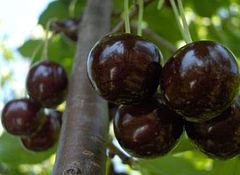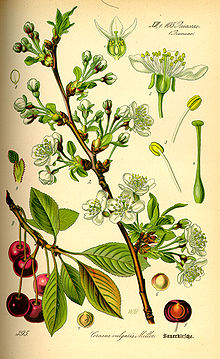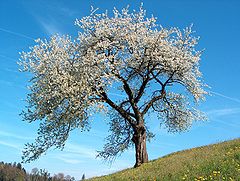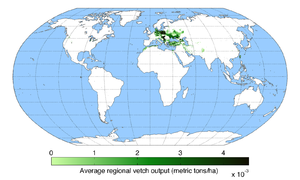- Prunus cerasus
-
This article is about the European and Asian tree in the genus Prunus. For the common Australian tree also known as "sour cherry", see Syzygium corynanthum.
Prunus cerasus 
Scientific classification Kingdom: Plantae (unranked): Angiosperms (unranked): Eudicots (unranked): Rosids Order: Rosales Family: Rosaceae Genus: Prunus Subgenus: Cerasus Species: P. cerasus Binomial name Prunus cerasus
L.Prunus cerasus, or the sour cherry, is a species of Prunus in the subgenus Cerasus (cherries), native to much of Europe and southwest Asia. It is closely related to the wild cherry (P. avium), but has a fruit that is more acidic.
The tree is smaller than the wild cherry (growing to a height of 4–10 m), has twiggy branches, and its crimson-to-near-black cherries are borne upon shorter stalks.
There are two varieties of the sour cherry: the dark-red morello cherry and the lighter-red amarelle cherry.[1]
Contents
Cultivation
Cultivated sour cherries were selected from wild specimens of Prunus cerasus and the doubtfully distinct P. acida from around the Caspian and Black Seas, and were known to the Greeks in 300 BC. They were also extremely popular with Persians and the Romans who introduced them into Britain long before the 1st century AD. The fruit remains popular in modern-day Iran.
In Britain, their cultivation was popularised in the 16th century in the time of Henry VIII. They became a popular crop amongst Kentish growers, and by 1640 over two dozen named cultivars were recorded. In the Americas, Massachusetts colonists planted the first sour cherry, 'Kentish Red', when they arrived.
Before the Second World War there were more than fifty cultivars of sour cherry in cultivation in England; today, however, few are grown commercially, and despite the continuation of named cultivars such as 'Kentish Red', 'Amarelles', 'Griottes' and 'Flemish', only the generic Morello is offered by most nurseries. This is a late-flowering variety, and thus misses more frosts than its sweet counterpart and is therefore a more reliable cropper. The Morello cherry ripens in mid to late summer, towards the end of August in southern England. It is self fertile, and would be a good pollenizer for other varieties if it did not flower so late in the season.
Sour cherries require similar cultivation conditions to pears, that is, they prefer a rich, well-drained, moist soil, although they demand more nitrogen and water than sweet cherries. Trees will do badly if waterlogged, but have greater tolerance of poor drainage than sweet varieties. As with sweet cherries, Morellos are traditionally cultivated by budding onto strong growing rootstocks, which produce trees too large for most gardens, although newer dwarfing rootstocks such as Colt and Gisella are now available. During spring, flowers should be protected, and trees weeded, mulched and sprayed with natural seaweed solution. This is also the time when any required pruning should be carried out (note that cherries should not be pruned during the dormant winter months). Morello cherry trees fruit on younger wood than sweet varieties, and thus can be pruned harder. They are usually grown as standards, but can be fan trained, cropping well even on cold walls, or grown as low bushes.
 Ripe sour cherries, Somogy, Hungary.
Ripe sour cherries, Somogy, Hungary.
Sour cherries suffer fewer pests and diseases than sweet cherries, although they are prone to heavy fruit losses from birds. In summer, fruit should be protected with netting. When harvesting fruit, they should be cut from the tree rather than risking damage by pulling the stalks. Morello cherries freeze well and retain their flavour superbly.
Unlike most sweet cherry varieties, sour cherries are self fertile (sometimes inaccurately referred to as self-pollinating) or self pollenizing. Two implications of this are that seeds generally run true to the cultivar, and that much smaller pollinator populations are needed because pollen only has to be moved within individual flowers. In areas where pollinators are scarce, growers find that stocking beehives in orchards improves yields.
Top Sour cherry Producers - 2009
Source: UN Food and Agriculture Organization (FAO)Rank Country Sour cherry production
(Metric Tonnes)1  Russia
Russia235,000[2] 2  Ukraine
Ukraine178,000[2] 3  Turkey
Turkey140,000[2] 4  Poland
Poland138,000[2] 5  Serbia
Serbia116,000[2] 6  USA
USA98,000[2] 7  Hungary
Hungary82,000[2] 8  Germany
Germany80,000[2] 9  Iran
Iran51,000[2] 10  Georgia
Georgia15,000[2] 11  Moldova
Moldova15,000[2] 12  Belarus
Belarus15,000[2] 13  Denmark
Denmark14,000[2] 14  Albania
Albania8,200[2] 15  Croatia
Croatia7,500[2] Uses
Sour cherries, unlike their sweet counterpart, are too sour for some people's tastes to be eaten fresh, although Europeans and Middle Easterners regularly do so. The taste is a unique blend of tartness, with perfume-like aromas that affect the over-all flavor.[citation needed] They can also be used in cooking, especially in soups and pork dishes, cakes, tarts, and pies. Also dried sour cherries are commonly used in cooking. They are also used in combination with sugar, which balances the acidity and brings out the fruit's aroma and flavor. Thus a variety of liqueurs, desserts, preserves and drinks are made with sour cherries or sour cherry syrup. In Greece and Cyprus, sour cherries are especially prized for making spoon sweet by slowly boiling pitted sour cherries and sugar; the syrup thereof is used for vyssináda, a refreshing beverage made by diluting the syrup with ice-cold water, or to garnish ice-cream and cakes.
See also
- Fruit trees
- Fruit tree forms
- Fruit tree propagation
- Ginjinha, a Portuguese liqueur made from Sour Cherry
- Pruning fruit trees
- Griotte de Kleparow
- Sour cherry soup
- Kirsch
- Kriek, a traditional Belgian beer made with sour cherries
- Vişinată, a Romanian drink made with sour cherries (vişina in Romanian)
- Vişne, Vişne Receli is a sour cherry preserve and Vişne Suyu is a popular fruit juice in Turkey
- Syzygium corynanthum, an Australian rainforest tree also known as the Sour cherry
References
- ^ Webster’s New International Dictionary of the English Language. Springfield, Massachusetts: G. & C. Merriam Co., 1913. See amarelle at p. 67.
- ^ a b c d e f g h i j k l m n o "Major Food and Agricultural Commodities and Producers". Food and Agricultural Organization of the United Nations. http://www.fao.org/es/ess/top/commodity.html?item=530&lang=en&year=2005.
Cherry cultivars Sweet (Bigaroon, Mazzard) Angela • Bing • Chelan • Chinook • Emperor Francis • Hudson • Lambert • Lapins • Rainier • Regina • Royal Ann (Napoleon) • Sam • Schmidt • Skeena • Stella • Sweetheart • Tieton • Ulster • Van
Sour (Amarelle, Morello) Balaton • Evans Cherry • Griotte de Kleparow • Montmorency
Other edible Ornamental Categories:- Cherries
- Pollination management
Wikimedia Foundation. 2010.



